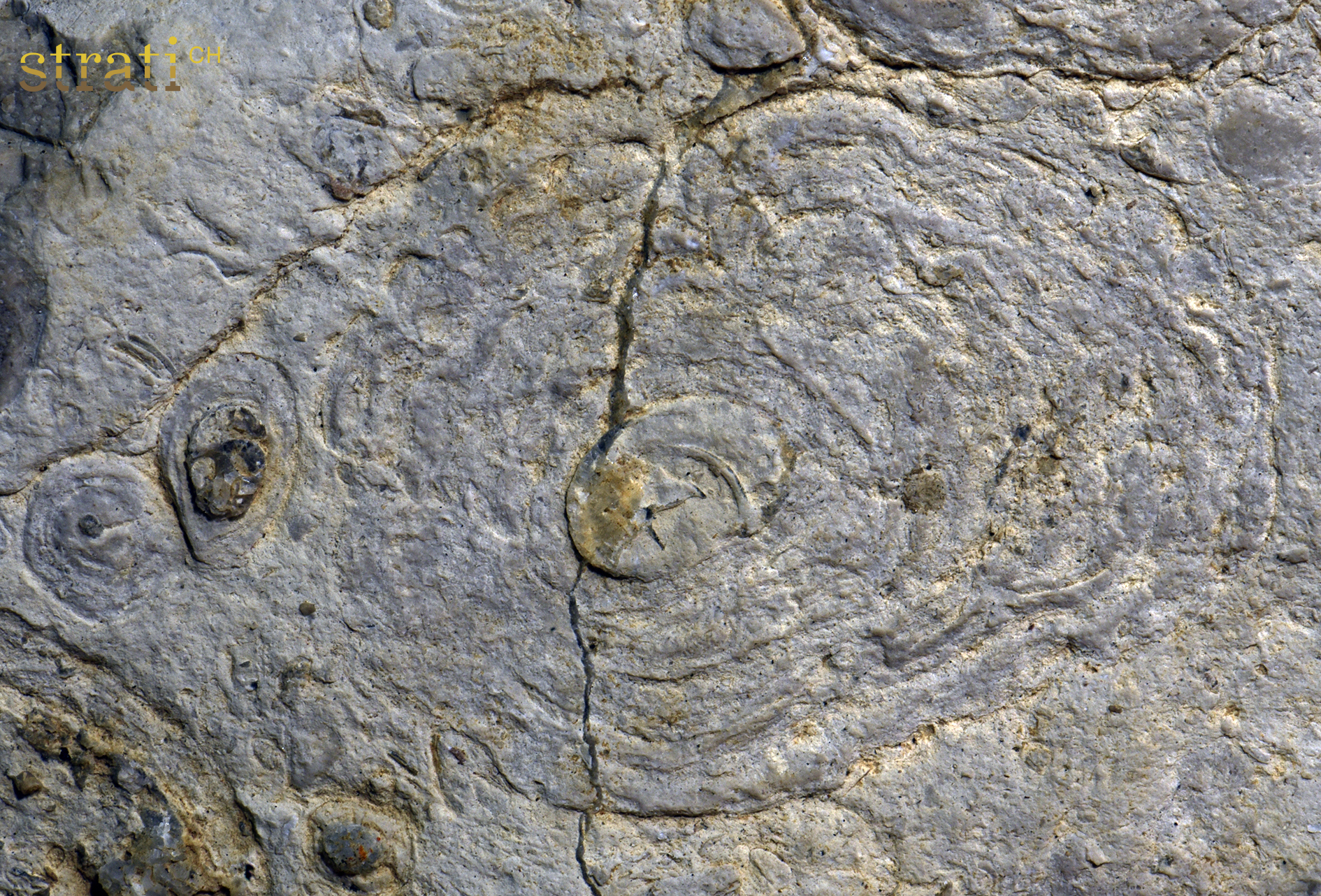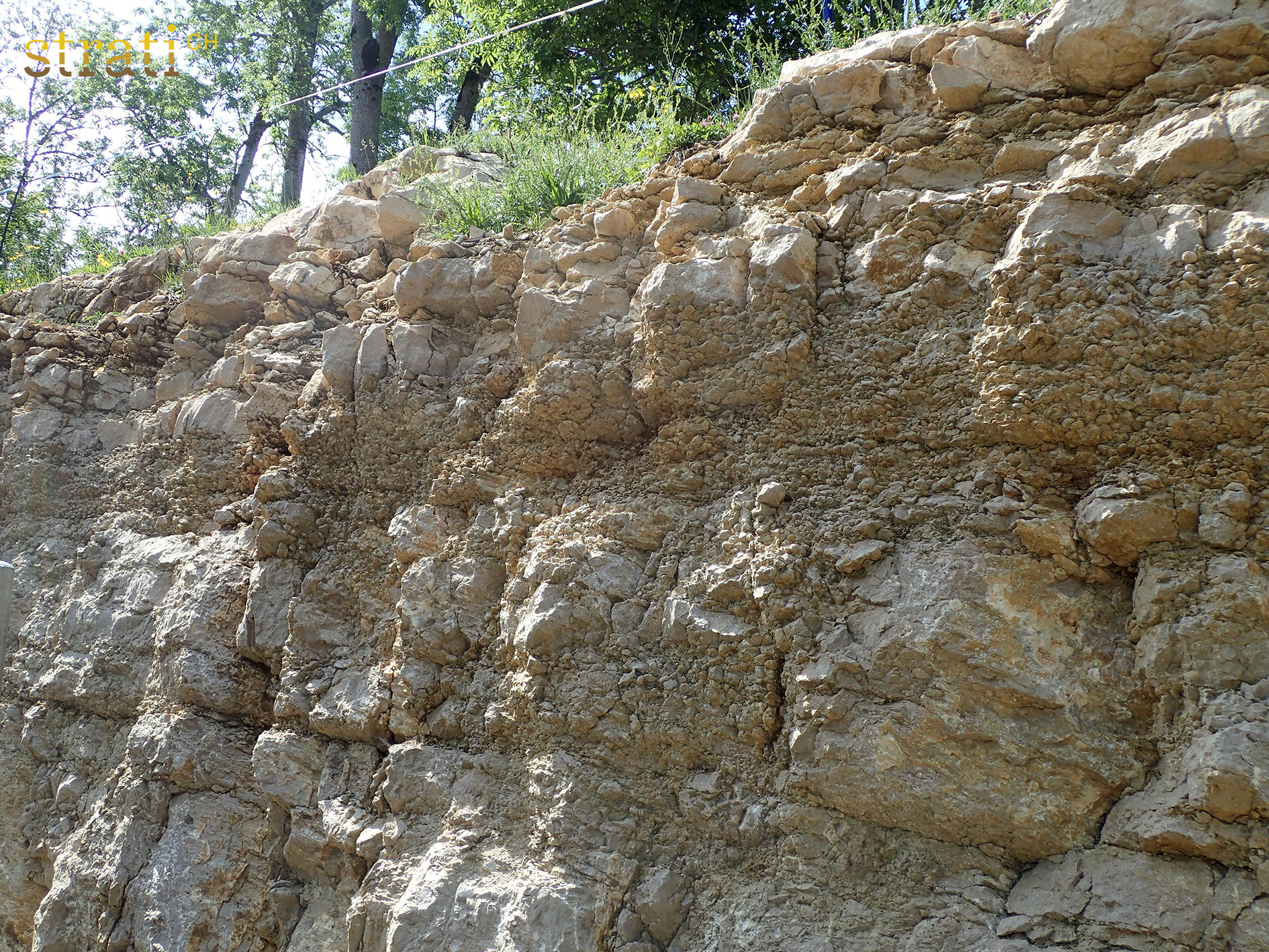Hauptmumienbank-Member
Retour à JuraReprésentation et statut
- Couleur CMYK
- siehe Vellerat-Formation
- Couleur RGB
- R: 170 G: 190 B: 165
- Rang
- Membre lithostratigraphique (Sous-formation)
- Usage
- Ce terme est en usage.
- Status
- terme formel valide
Nomenclature
- Deutsch
- Hauptmumienbank-Member
- Français
- Membre du Hauptmumienbank (Oolithe nuciforme)
- Italiano
- Membro del Hauptmumienbank
- English
- Hauptmumienbank Member
- Origine du nom
-
Mumien sind Onkoiden mit ein Fossil als Kern (Steinmann 1880).
- Variantes historiques
-
Calcaires blanchâtres à grosses oolithes (Rollier 1888a), Mumienbank (Rothpletz 1933), Hauptmumienbank (Ziegler 1956 S.41, Bolliger & Burri 1970 S.72, Heckendorn 1974), Hauptmumienbank Member (Gygi 2000b, Gygi 2000c), Oolithe nuciforme
- Remarques nomenclatoriales
-
en français: "h" aspiré >>> le [non: l']
Links
- Synonymes
Description
- Description
-
Leithorizont im mittleren Teil (bzw. im Dach) der Vellerat-Formation, bestehend aus dickbankigen, harten und massiven hellgrauen, mikritischen Kalksteinen, welche lokal zahlreichen Onkoiden (5 bis 20 mm gross) aufweisen. Nach Osten eher gelblicher Oosparit und Pelsparit, manchmal dolomitisch.
- Géomorphologie
- Markante Rippe oder Stufe. Deutlich herauswitternder Kartierhorizont über dem Röschenz-Member.
- Épaisseur
- 5-7 m, bis 10 m gegen NW (Aufranc et al. 2017).
Composants
- coraux
- brachiopodes
- bivalves
Térébratules
Hiérarchie et succession
- Unité hiérarchiquement supérieure
- Unités sus-jacentes
- Unités sous-jacentes
- Limite supérieure
-
Oolite-Rousse-Mb.
- Limite inférieure
-
Röschenz-Mb.
Âge
- Âge au sommet
-
- Oxfordien tardif
- Âge à la base
-
- Oxfordien tardif
- Méthode de datation
-
keine
Géographie
- Extension géographique
- Zentraler Schweizer Jura. Aussi présent en Franche-Comté sous forme de banc à oncoïdes algaires vers Pontarlier (et au nord des Verrières) ou à oncoïdes à nubéculaires et bioclastes plus au nord.
- Typusprofil
-
-
Chapelle de Vorbourg (JU)
Particularités du site- Obergrenze
- Untergrenze
- typische Fazies
- Strassenanschnitt / Bahnanschnitt
- (2593830 / 1247580)
- Gygi 2000b Pl.23 Profil RG366 Schichten 67-73
-
Chapelle de Vorbourg (JU)
- Coupes de référence
-
-
Les Breuleux (JU)
Particularités du site- typische Fazies
- Strassenanschnitt / Bahnanschnitt
- (2567100 / 1230010)
- Strasse Les Breuleux-Le Roselet, Kote 1060 m
-
Les Breuleux (JU)
Paléogéographie et tectonique
-
- Malm
- Paléogéographie
- bassin argovien , bassin souabe
- Termes génériques
-
-
Jura
:
Juragebirge
-
Jura
:
- Type de protolithe
-
- sédimentaire
- Conditions de formation
-
- Mit dem Ausklingen der Tonschüttung war das einstige Relief durch das Röschenz-Member, die Günsberg-Formation und das Effingen-Member weitgehend ausgeglichen und erstreckte sich weit in Richtung des argovisch-schwäbischen Beckens. Im untiefen, wenig bewegten Wasser folgte bis ans Ende der Jurazeit eine Phase fast reiner Karbonatproduktion, beginnend mit der sich weit hinauserstreckenden Hauptmumienbank.
- Métamorphisme
- non métamorphique
Références
- Révision
-
(2000) :
Annotated index of lithostratigraphic units currently used in the Upper Jurassic of northern Switzerland. Eclogae geol. Helv. 93/1, 125-146
p.132: Hauptmumienbank Member (Ziegler 1956) ; Member of the Vellerat Formation ; Synonymy: Gygi (2000b, p. 59)
The name "Hauptmumienbank" was introduced by Ziegler (1956. p. 42). It means main mummy bed. Steinmann (1880, p.152) called an oncoid a mummy when the core is a recognizeable macrofossil. Gygi & Persoz (1986. p. 4(X)) used the term Hauptmumienbank Member for the whole limestone succession between the marls and marly limestones of the Röschenz Member (Gygi 1995. p. 11) below and the Bure Member (Gygi 1995. p. 11) or Oolithe rousse Member above. Ziegler (1956) did not designate a type section. The best section accessible to the public is now section RG 366 near Vorbourg chapel at Delémont. LK 1086 Delémont. The Hauptmumienbank Member there crops out along the road at coordinates 593.830/247.580. This is section RG 366 in Gygi (2000b. PI. 23). Beds no. 67-73 of the succession at this locality can be regarded as type section ofthe Hauptmumienbank Member.
The member in section RG 366 at Delémont is underlain by the marly Röschenz Member and overlain by the Oolithe rousse Member. The thickness of the Hauptmumienbank Member is normally only a few meters, but it may grow to more than 10 m where it grades laterally into the Steinebach Member as in section RG 381 in Court gorge at Moutier BE (Pl. 28 in Gygi 2000b). (...)
The oncoid content is normally greatest near the top of the member. There are no ammonites to date the Hauptmumienbank Member biochronologically. Gygi & Persoz (1986. Pl.IA) indicated with clay minerals that the oolitic Steinebach Member and the basinal Geissberg Member are time equivalents of the Hauptmumienbank Member. Gygi (1995. Fig. 23) could prove with an ammonite from the upper Geissberg Member at Olten that these three members belong to the later part of the Hypselum Subchron (Gygi 1995. Fig. 2). The great geographic range of the Hauptmumienbank Member can be read from Ziegler (1956. Fig. 12) and Gygi (1990c. Fig. 7).


